![]()
![]()
![]()
Use LEFT and RIGHT arrow keys to navigate between flashcards;
Use UP and DOWN arrow keys to flip the card;
H to show hint;
A reads text to speech;
75 Cards in this Set
- Front
- Back
|
5 Consequences of Arrhythmias:
|
Palpitations
Dizziness Dyspnea Anxiety Chest pain |
|

What's this? What are consequences of it?
|

*AFib; a consequence of arrhythmia.
*Decreased cardiac output *Stroke |
|

What's this? What are consequences of it?
|

*VT; a consequence of arrhythmia.
*Syncope *VF--> Death |
|
|
Goals of Antiarrhythmic Therapy: 4
|
*Preventing the recurrence of arrhythmia.
*Reducing the frequency of paroxysmal arrhythmia. *Slowing the heart rate in the setting of arrhythmia. *Terminating an arrhythmia. |
|
|
Mechanisms of Arrhythmia Drug Therapy:
|
*Majority of antiarrhythmic agents inhibit ion channels to stabilize the myocardial membrane and maintain sinus rhythm:
-Reduce conduction velocity (Na+ channels). -Prolong refractory period (K+ channels). |
|
|
Review diagram of Cardiac AP with ion channels for each phase listed:
|
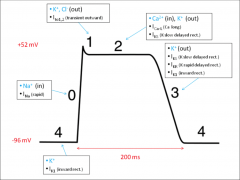
|
|
|
Common Antiarrhythmic Agents: (lots)
|
Procainamide*
Quinidine Disopyramide Lidocaine* Mexilitine Flecainide Propafenone Propanolol Metoprolol Carvedilol Ibutilide* Dofetilide Sotalol* Amiodarone* Dronedarone Verapamil* Diltiazem* Adenosine* Digoxin* Magnesium* *2010 ACLS Emergency Drugs |
|
|
Vaughan-Williams Classification: types I thru IV:
|
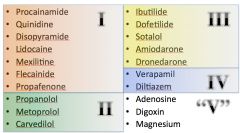
|
|
|
Discuss details of the Vaughan-Williams Classification system:
|
*Oversimplified physiologic classification
-Class I: modulates sodium channels -Class II: beta-blockers -Class III: modulates potassium channels -Class IV: calcium channel blockers *Many agents can have several effects ACROSS multiple classes. *Classification is based on MAIN effect. |
|
|
What are the Class I Antiarrhythmic Agents? 7
|
Procainamide*
Quinidine Disopyramide Lidocaine* Mexilitine Flecainide Propafenone |
|
|
How do class I antiarrhythmics work?
|
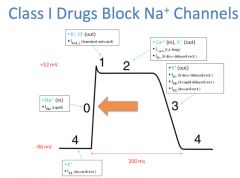
|
|
|
How do class I antiarrhythmics selectively block Na channels?
|
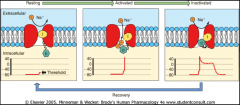
*Na+ Channel blocking agents block when channels are open or inactive (phases 0-3).
*Then they dissociate from the receptor when channels are at rest (phase 4). |
|
|
What does it mean to say that Class I Meds are Use-Dependent?
|
*When heart rate increases, there is less time for dissociation, resulting in increased number of blocked channels.
*The potency of the drug increases with rapid rates, which is ideal for targeting tachyarrhythmias. *Anything that slows the rate of dissociation will also increase potency (e.g. ischemia). |
|
|
Describe the Mechanics of Use-Dependence:
|
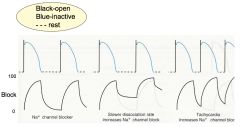
*Dotted line = drug dissociation.
*In ischemia, there's less dissociation in phase IV. *More channels gets blocked as heart rate increases. |
|
|
What are the Class I Subgroups?
How strong are they relative to each other? |
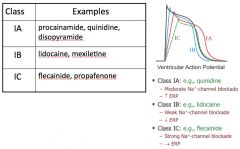
|
|
|
Compare strength of the Class I Subgroups:
Which meds are in each group? |
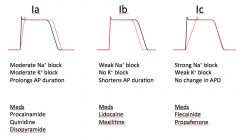
|
|
|
Describe Uses of Procainamide:
|
*Used for hemodynamically stable monomorphic ventricular tachycardia (VT) or pre-excited atrial fibrillation (WPW).
|
|
|
Usage guidelines for Procainamide:
When do you want to STOP it? |
*Administer intravenously 20-50 mg/min or 100 mg every 5 min (don't need to know for this test).
*Must stop infusion for the following: -Hypotension. -QRS interval widens >50%. -Total of 17 mg/kg given. -Termination of arrhythmia. |
|
|
How is Procainamide metabolized? What are the implications of this?
|
*Acetylated in the liver to N-acetylprocainamide (NAPA).
*NAPA has equipotent class III antiarrhythmic activity (IKr blocker) but has twice the half-life. *Over time, accumulation of NAPA contributes to proarrhythmia and may induce Torsades de Pointes (TdP). |
|
|
Discuss TdP:
|
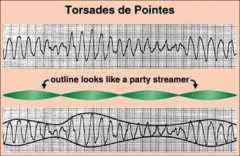
*“Twisting of Spikes” aka polymorphic VT.
*Extremely dangerous rhythm that may quickly degenerate to ventricular fibrillation (VF). *Can occcur with many other antiarrhythmics. |
|
|
Problems With Procainamide:
|
*It's metabolite, NAPA.
*Potentially fatal blood dyscrasias (agranulocytosis). *Drug-induced LUPUS (20-30%; board question?). *GI disorder (9-12%). *Hypotension (5%). *It's mainly used in code settings. |
|
|
What is Quinidine?
|
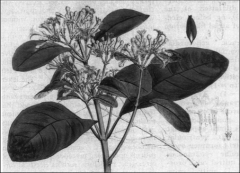
*Stereoisomer of quinine, derived from bark of cinchona tree.
*Identified to have antiarrhythmic properties by Wenckebach in 1912. *NOT the same thing as QUININE. |
|
|
What are the Problems With Quinidine?
|
*“Quinidine syncope” --> it can lead to TdP.
*Can also cause cinchonism (high frequency hearing loss, blurry vision, confusion). *Not typically used for arrhythmias now. *Still used for treatment of severe cases of malaria (P. falciparum). |
|
|
Discuss Disopyramide:
|
*Not a popular agent due to anti-cholinergic properties.
*Can cause acute CHF and hypotension. *Used off-label for treatment of hypertrophic cardiomyopathy. *May be useful for vagally-induced atrial fibrillation (AF). |
|
|
What are the Class Ib drugs?
|
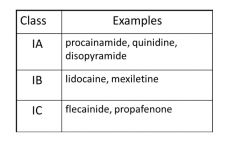
|
|
|
Discuss lidocaine:
|
*Itravenous Ib antiarrhythmic.
*SECOND-LINE ACLS agent for VF or pulseless VT when amiodarone is not available. *Alternative agent for hemodynamically stable monomorphic VT. *Administer 1-1.5 mg/kg; repeat with 0.5-0.75 mg/kg every 5-10 minutes. |
|
|
What's the nice thing about lidocaine? Specifically related to administration...
|

*Loading dose can be given down endotracheal tube 2-2.5x IV dose diluted in 5-10 ml normal saline or water.
*Can also be given IO (intraosseous). |
|
|
Problems with lidocaine:
|
*Generally well tolerated but toxicity results in CNS effects (tremors, parasthesias, delirium).
*Commonly used as a local anesthetic, which is not usually associated with proarrhythmic effects when administered properly. |
|
|
Discuss Mexilitine:
|
*Oral Ib antiarrhythmic.
*Like lidocaine, also used for ventricular arrhythmias but not as effective as other agents. |
|
|
What are the Class Ic drugs?
|
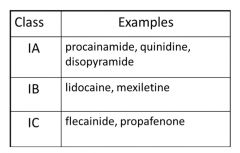
|
|
|
Discuss Flecainide:
Who should NOT use it? |
*Potent INa blocker with high use-dependence.
*Very effective for treating paroxysmal AF or other supraventricular tachyarrhythmias (SVT). *Contraindicated in patients with structural heart disease (MI, LVH, cardiomyopathy). *Non-cardiac side effects relatively mild. |
|
|
Issues with Flecainide:
|
*Slows conduction and can prolong QRS.
*May induce 1:1 AV conduction when treating atrial flutter; requires pre-emptive therapy with a negative chronotropic agent (e.g. beta-blockers! or Ca channel blockers!). |
|
|
Discuss Propafenone:
|
*Used to treat paroxysmal AF.
*Avoid in patients with structural heart disease. *Has some class II properties. *15-20% discontinue the drug due to side effects (unusual taste, nausea, dizziness). |
|
|
What are the class II drugs?
|
Propanolol
Metoprolol Carvedilol |
|
|
Discuss Beta-Blockers:
What bindings differences are there b/t the different ones? |
*Bind to b-adrenoceptors and block the binding of epinephrine and norepinephrine.
*Propanolol: non-selective blockade of both ß1 and ß2 receptors. *Metoprolol: cardioselective ß1-blocker at lower doses. Used as antiarrhythmic and to slow HR. *Carvedilol: ß1ß2a1-blocking effect causing concomitant peripheral vasodilation. Used in HF patients. |
|
|
Mechanism of Beta-Blockers:
|
*Alters or blocks catecholamine and sympathetically mediated actions:
-Reduces automaticity in the SA node. -Reduces membrane excitability. -Reduces rate of impulse conduction through myocardial membrane. -Reduces delayed afterpotentials that lead to ectopic depolarizations. |
|
|
How are Beta-Blockers used for treating arrhythmia?
|
*Slows ventricular rate in RAPID AF and other SVTs.
*Can be used in certain rare types of idiopathic VT. *Relatively safe and well tolerated. *Side effects include bradycardia, fatigue, erectile dysfunction. |
|
|
WHAT ARE THE Class III Antiarrhythmic Agents?
|
Ibutilide
Dofetilide Sotalol Amiodarone Dronedarone |
|
|
Mechanism of Class III Antiarrhythmic Agents:
|
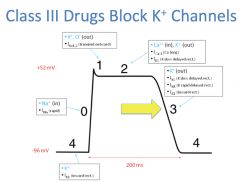
*Some are more selective of certain K channels; some are less selective.
|
|
|
What effect do class III Antiarrhythmic Agents have on ERP?
|
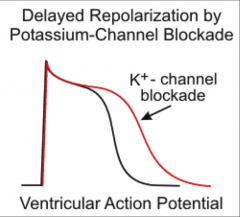
*Slow down the arrhythmia.
|
|
|
Discuss the use-dependence properties of class III Antiarrhythmic Agents:
any dangers in this? |

*Reverse Use-Dependence!
*In contrast to class I, class III drugs become stronger at LOWER heart rates. *This occurs because K+ channels are blocked mainly in the resting state (phase 4). *Prolongs QT interval and can lead to TdP. *Strip shows bradycardia and a long QT interval. *R on T --> TdP. |
|
|
Discuss Ibutilide:
CIs? |
*Used for the acute termination of AF and flutter of recent onset.
*Most effective when AF has been present for seven days OR LESS. *2% develop TdP requiring cardioversion. *Contraindicated in patients with prolonged QT or with structural heart disease. |
|
|
Discuss Dofetilide:
CIs? |
*Used for the termination of AF and flutter as well as PREVENTION of recurrence.
*Can be effective even if arrhythmia is OLDER than seven days. *SAFE TO USE in patients with CHF or prior MI. *3% develop TdP. *Contraindicated in patients with prolonged QT. |
|
|
Discuss Sotalol:
CIs? |
*Actually a beta-blocker with class III effects! Yay!
*Used to PREVENT RECURRENCE of AF. *LESS TOXIC compared to other antiarrhythmic drugs for treatment of AF. *Contraindicated in patients with RENAL dysfunction or HEART FAILURE. *Off-label use for stable monomorphic VT but typically second-line therapy AFTER amiodarone. *Administer 1.5 mg/kg over 5 min. |
|
|
Amiodarone:
HOW DOES IT WORK, HUH? |
*Exact physiologic mechanism is not completely understood.
*Exhibits properties from all four Vaughan-Williams classifications: -Blocks Na+ channels. -Anti-adrenergic properties. -Blocks Ca++ channels. *Prolongs QT interval but DOES NOT cause TdP. *The most effective antiarrhythmic agent in our arsenal (good potency and safety). *Prevention of recurrent AF (especially with CHF). *One of the few drugs SAFE TO USE in patients with heart failure. |
|
|
Usage guidelines for Amiodarone per ACLS:
|
FIRST LINE AGENT FOR:
*Pulseless VT/VF arrest: -300 mg rapid bolus IV; then 150 mg. -1 mg/min for 6 hrs; then 0.5 mg/min for 18 hrs. *Stable monomorphic VT: -150 mg infusion over 10 min. -1 mg/min for 6 hrs; then 0.5 mg/min for 18 hrs. |
|
|
Major Side Effects of Amiodarone:
|
*Pulmonary toxicity, hepatotoxicity, and thyroid dysfunction.
*“Check PFTs, LFTs, TFTs.” *Prevalence of side effects 15% after one year and AS HIGH AS 50% WITH LONG TERM THERAPY. *May consider less potent alternatives in younger patients first before considering amiodarone. |
|
|
Minor Issues with Amiodarone:
t 1/2? drug interactions? CIs? |
*Lipophilic, requiring a long loading period.
*Effective half-life up to 50 days. *Drug interacts with warfarin and digoxin, increasing their effects, may need to decrease their doses by 33-50%. *Contraindicated if patient is allergic to iodine, or has pre-existing pulmonary, liver, and thyroid dysfunction. |
|
|
Discuss Dronedarone:
|
*Non-iodinated congener of amiodarone.
*Used for maintenance of sinus rhythm in patients with paroxysmal AF. *Can also be used in patients with CAD. *Shorter half-life of 24 hours. *Not associated with thyroid toxicity. |
|
|
Is Dronedarone as good as Amiodarone?
Why or why not? |
*NNNNNNNNNNNNNNO!
*Dronedarone is not currently indicated for treatment of VT. *Contraindicated in patients with CHF (increases mortality). *Can cause pulmonary and hepatic injury. *Antiarrhythmic effect is not as good as amiodarone. |
|
|
Any future drugs on the horizon in class III?
|
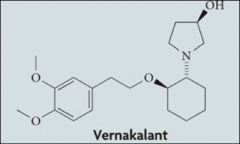
*Vernakalant.
*Not currently approved in the United States. *Selectively blocks currents in atrium (IKur). *The idea is to prolong the atrial refractory period with minimal effects on the ventricle, theoretically minimizing pro-arrhythmic complications. |
|
|
List a couple of class IV drugs:
|
*Calcium Channel Blockers:
Verapamil Diltiazem |
|
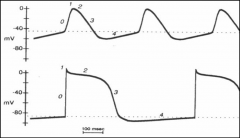
What makes PCM myocytes special?
|
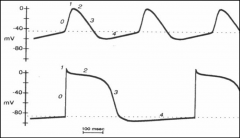
Top: SA/AV Nodes (Ca)
Bottom: Purkinje Fiber (Na) *It's all about phase 0. Ca blockers delay automaticity in SA and AV nodes, and therefore HR. |
|
|
Ion channel components of SA and AV node APs:
|
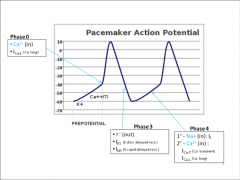
|
|
|
What's so special about the Non-dihydropyridine Blockers?
What are 2 important ones? |
*These are the only Ca channel blockers I need to care about.
*Only certain Ca++ blockers have significant anti-arrhythmic effects: verapamil & diltiazem. *Inhibits the ICa-L current: -Reduces SA node automaticity. -Increases AV refractoriness. -Slows AV node conduction. *Primarily used to slow ventricular rate for treatment of SVT, similar to class II drugs. |
|
|
How do Verapamil & Diltiazem compare to each other?
|
*Verapamil is stronger than diltiazem.
*Can depress left ventricular function so not recommended in patients with heart failure. *Otherwise generally safe and well-tolerated. |
|
|
List the class V antiarrhythmics: 3
|
"Non-classified Antiarrhythmics":
-Adenosine -Digoxin -Magnesium |
|
|
What is Adenosine?
What does it do in the cell? |
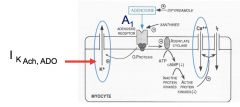
*Nucleoside that stimulates A1 receptors that inhibit adenylate cyclase activity:
-activates outward K+ channels. -inhibits inward Ca++ channels in myocytes. |
|
|
What are the Two Effects of Adenosine?
|

|
|
|
What do we use Adenosine for?
Side effects? |
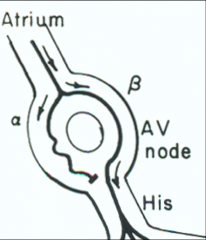
*Use Adenosine for Acute SVT.
*Half-life only 10 seconds. *Can induce transient AV block. -Used to Identify atrial rhythm. -Used to terminate AVNRT (AV nodal reentry tachycardia). *Side effects: -Facial flushing. -Sensation of “impending doom.” |
|
|
You know how Digoxin works. Tell it.
|
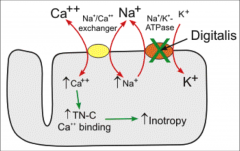
*Purified cardiac glycoside extracted from foxglove plant.
*Historically used to treat chronic heart failure. |
|
|
Describe the Vagotonic Activity of Digoxin:
|
*Increases vagal activity to the heart, which reduces conduction velocity through AV node (negative dromotropy).
*Effect is not very strong and easily overcome by increased sympathetic tone (exercising). *Generally second-line agent for rate control of AF and other SVTs after class II or IV agents. *Good for treating rapid AF in setting of hypotension. Because it doesn't really lower the BP. |
|
|
Describe the Proarrhythmic Effects of Digoxin:
|

*Increased atrial and ventricular ectopy.
*Atrial tachycardia. *Premature ventricular complexes (PVC). *Bigeminy or bidirectional PVCs. *Can result in paroxysmal atrial tachycardia with AV block. |
|
|
How do you treat digitoxicity?
When would you WANT to treat it? 3 cases. |
*Difficult to maintain therapeutic window.
*Renal dysfunction and drug interactions can potentiate dangerous arrhythmias. *Administer digoxin-specific antibody (Fab) fragments only in severe cases: -Life-threatening arrhythmia -End-organ damage -Hyperkalemia (Potassium >5 meq/L) |
|
|
Discuss Magnesium Sulfate.
What's it used for? How does it work? |
*Mineral involved in transmembrane and intracellular modulation of ion channels.
*Hypomagnesemia increases risk of TdP. *Can be used to treat TdP or refractory VF. *Effectiveness related to membrane-stabilizing effect but exact mechanism is unclear. |
|
|
Summary diagram of sites of action of the antiarrhythmic drugs:
|
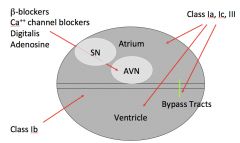
*Bypass tract--> WPW tract.
|
|
|
*56 year old man with AF.
*Recent diagnosis of paroxysmal AF, currently in sinus rhythm but he reports palpitations and dyspnea during episodes. *History of HTN, but no CAD or CHF. *Physical exam and lab tests were normal. *Tests did not reveal any LVH or prolonged QT. *Which antiarrhythmic agents are appropriate? |
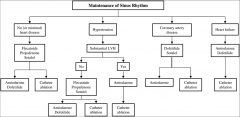
*Flecainide or propafenone.
|
|
|
Master algorithm for treating AF:
|
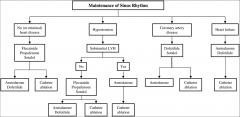
*You should know the HF drugs on the right.
|
|
|
2010 ACLS guidelines for Pulseless VT/VF:
|

*Bolus amiodarone 300 mg IV push after the third shock
*Second dose 150 mg IV |
|
|
ACLS guidelines for Adult Tachycardia:
|
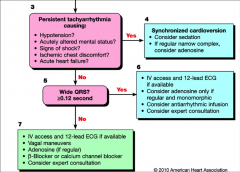
*Note adenosine, ß, and Ca blockers.
|
|
|
ACLS: what do you do for Stable wide-complex tachycardia with pulse?
|
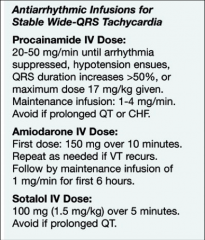
Use class I or III agents
|
|
|
Discuss defibrillators for VT/VF:
|

Defibrillation delivers a non-synchronized high-energy shock to terminate pulseless VT or VF.
|
|
|
Discuss defibrillators for AF/SVT:
|

Cardioversion delivers a synchronized shock to terminate AF and SVT
|
|
|
When are implantable devices indicated?
|
*Pacemakers:
-Mainly to treat bradyarrhythmias. -Some are used to treat AF. -Only function is to pace. *Implantable Cardioverter-Defibrillators (ICD): -Capable of delivering a shock to treat VT. -Indicated for primary prevention in patients with severe cardiomyopathy. |
|
|
When is ABL indicated?
|
*A procedure that delivers focused energy to specific locations inside the heart.
*Interrupt the circuit for reentry arrhythmias: High cure rate for flutter, AVNRT, WPW. Moderate success for AF or VT. |

